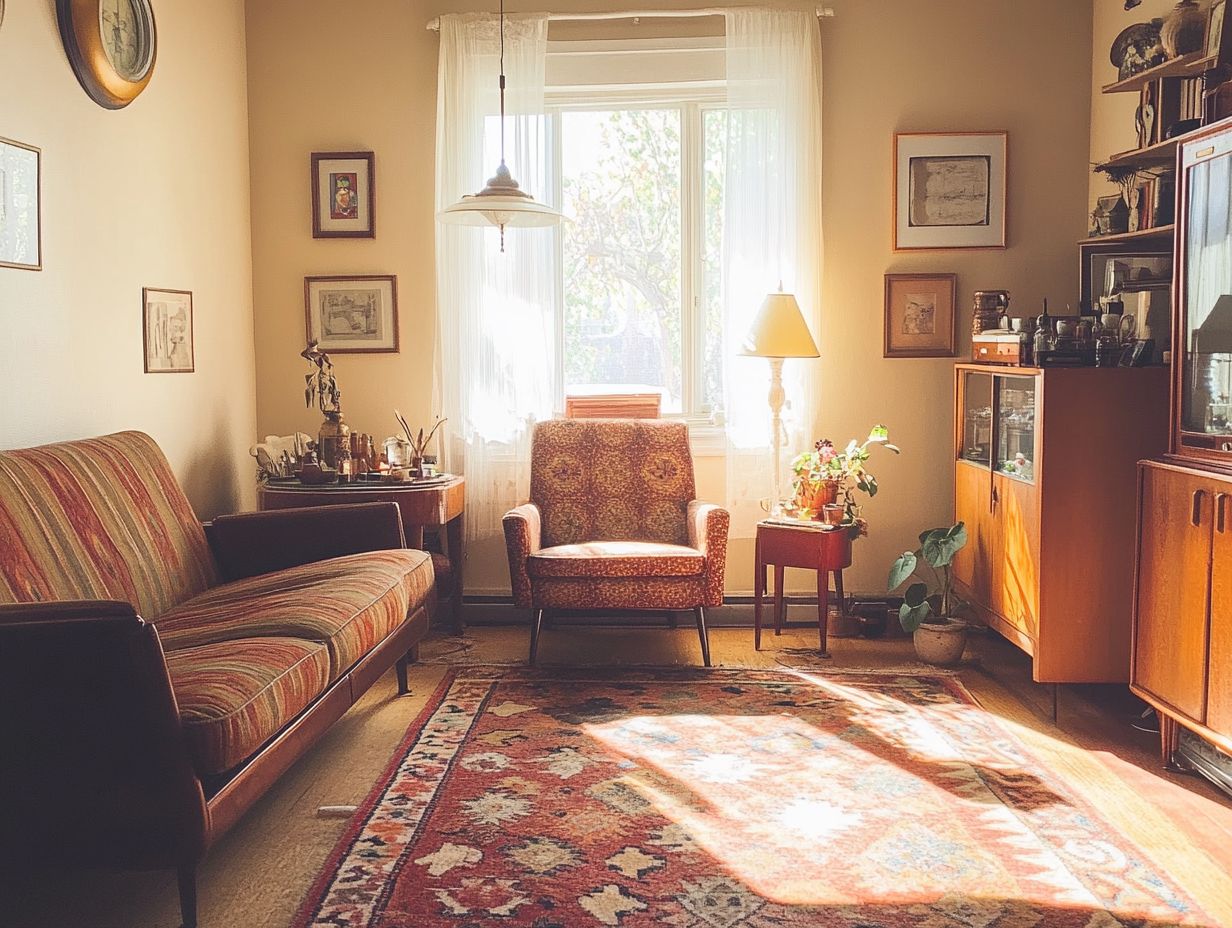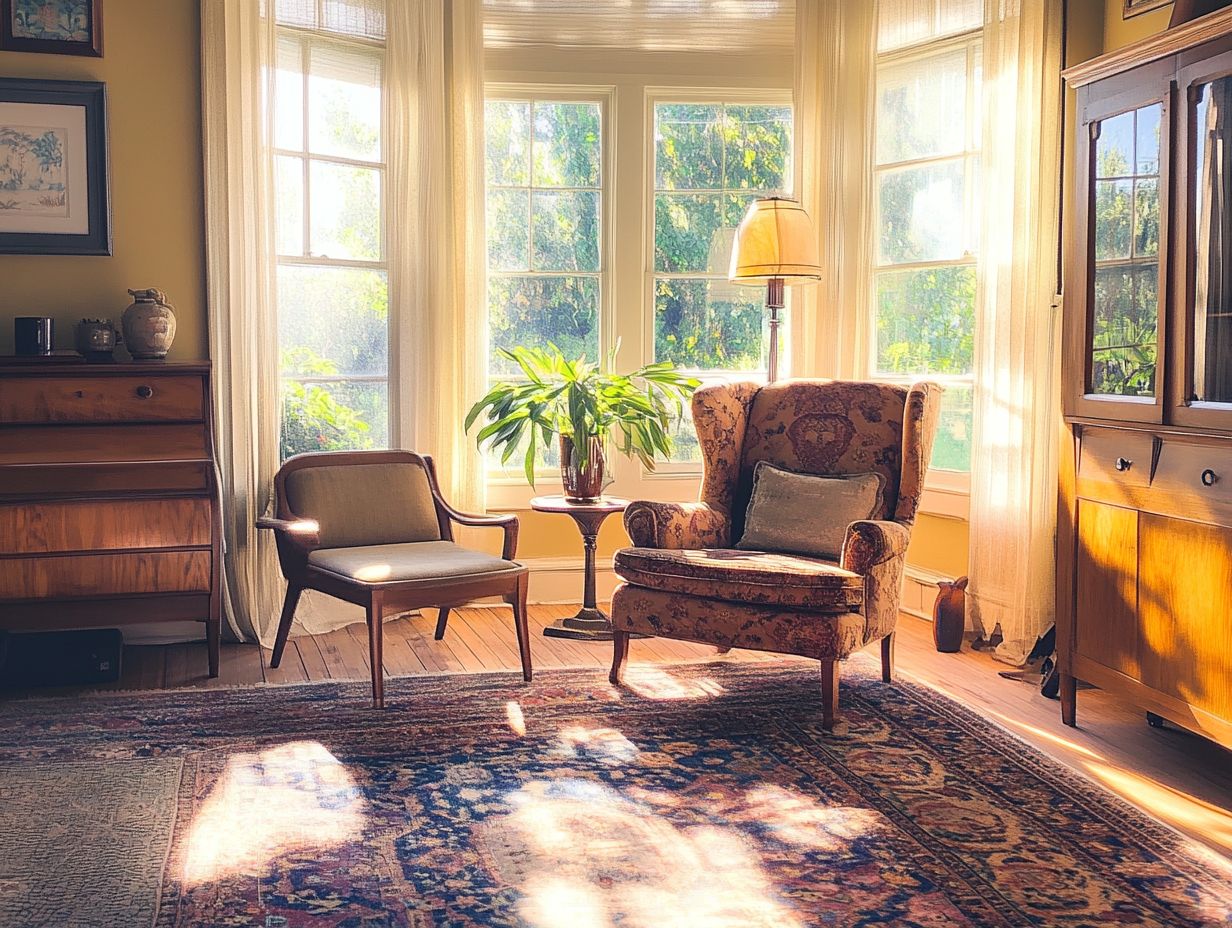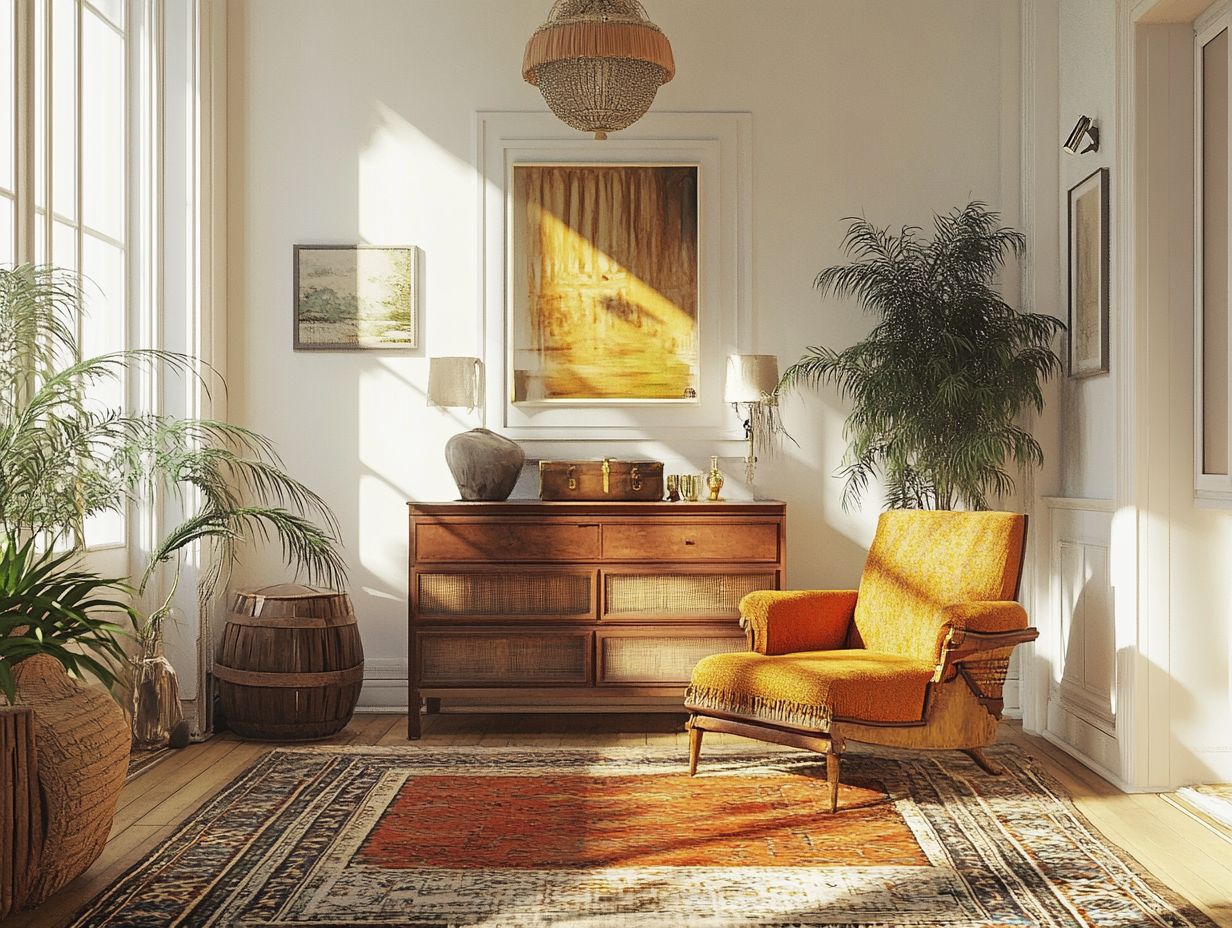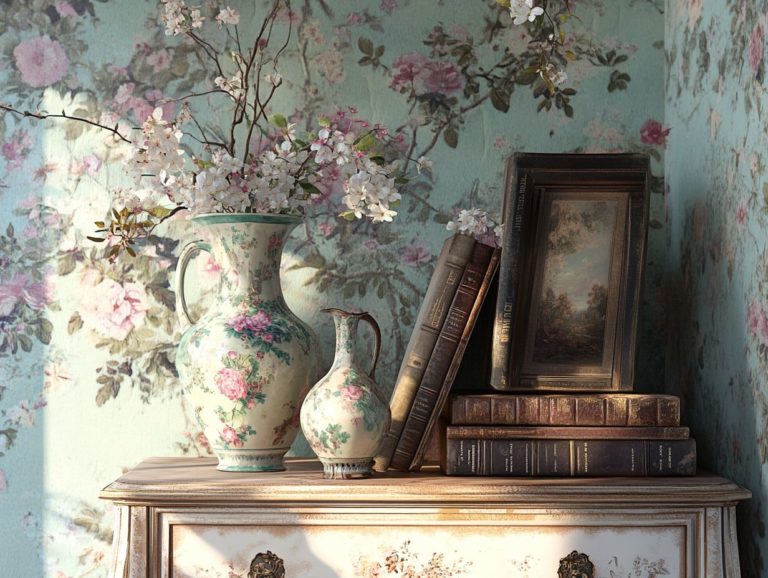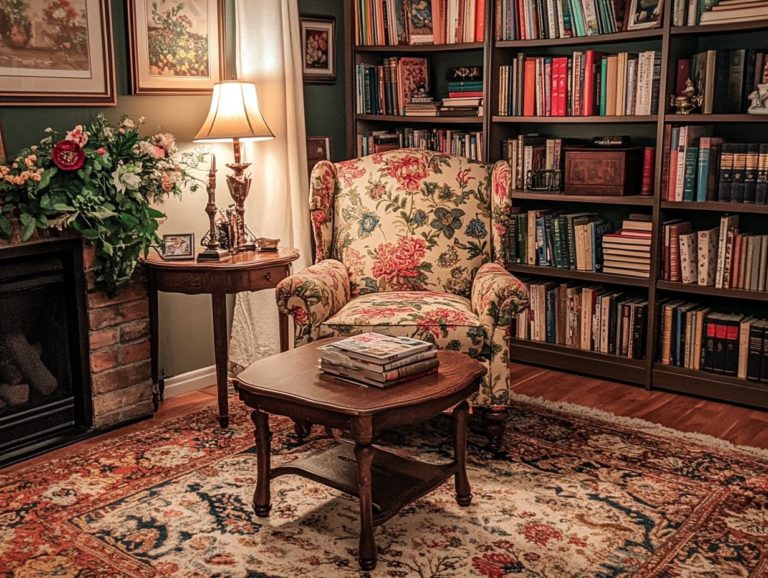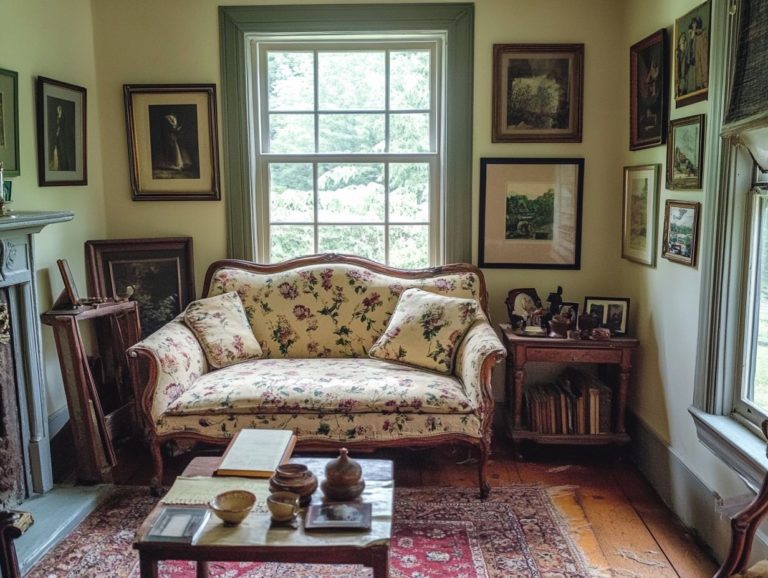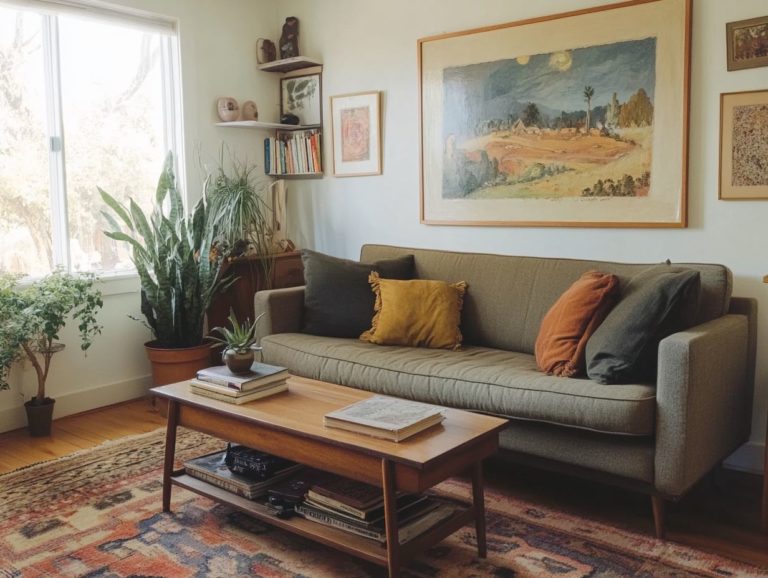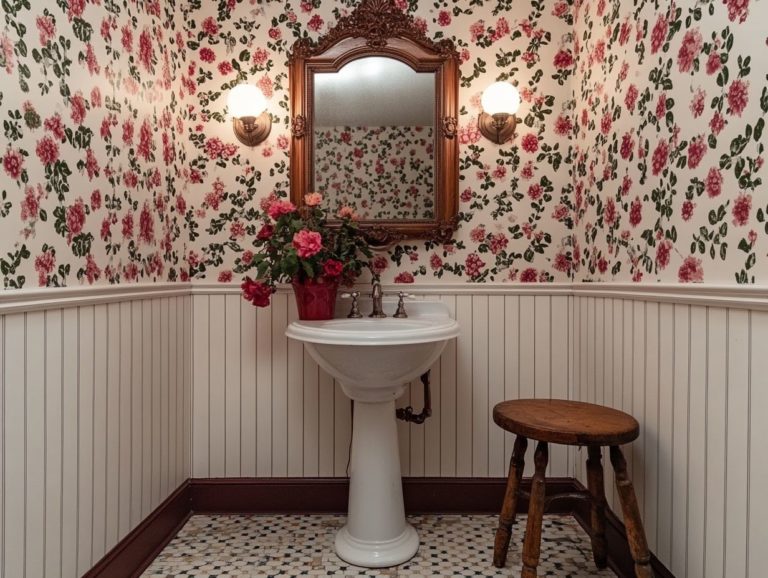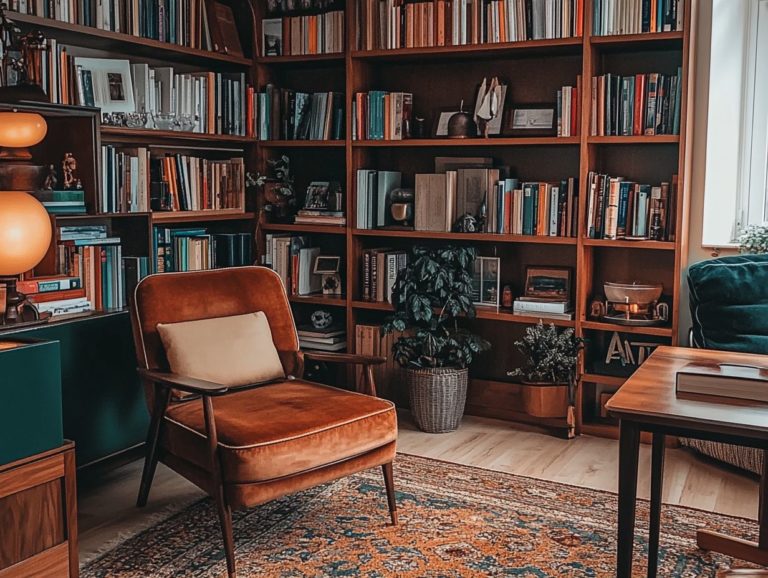Top 10 Vintage Home Decor Styles You Should Know
Vintage home decor offers a unique blend of nostalgia and charm, transforming spaces into reflections of the past and incorporating various design styles.
From the ornate elegance of Victorian style to the clean lines of Mid-Century Modern, each decor style tells a story rooted in its time.
Get ready to dive into ten captivating vintage styles that can transform your space today! This piece highlights their defining characteristics, key elements, and enduring appeal.
Whether you’re redecorating or simply curious about design history, you’ll discover inspiration to infuse your home with timeless elegance.
Contents
- Key Takeaways:
- Victorian Style
- Art Deco Style
- Mid-Century Modern Style
- Retro Style
- Defining Features and Popular Trends
- Bohemian Style
- Cultural Influences and Decorative Elements in Design Styles
- Industrial Style and Neo-Industrial Design
- Farmhouse Style
- Shabby Chic Style
- Scandinavian Style and Minimalism
- Frequently Asked Questions in Interior Design Styles
- 1. What are the top 10 vintage home decor styles that I should know?
- 2. What makes Art Deco a popular vintage home decor style?
- 3. How would you describe Mid-Century Modern home decor?
- 4. What elements are essential in creating a Victorian-style home?
- 5. How can I incorporate Shabby Chic into my home decor?
- 6. What is the key to achieving a Bohemian home decor style?
Key Takeaways:
- Victorian style exudes elegance and opulence with intricate details and ornate furnishings, perfect for those who appreciate traditional design and luxurious living.
- Mid-century modern style is characterized by clean lines, simple forms, and functional furniture, making it a timeless and versatile option for modern homes.
- Bohemian style embraces a free-spirited and eclectic vibe with vibrant colors, patterns, and textures, making it a great choice for those who love a boho-chic aesthetic.
What is Vintage Home Decor?
Vintage home decor represents a timeless aesthetic that integrates unique finds from various eras, resulting in distinctive and inviting spaces.
This style emphasizes the incorporation of vintage furniture, accessories, and textiles, often distinguished by their charm and craftsmanship.
This design evokes nostalgia and promotes sustainability through vintage shopping and repurposing items. It is a popular choice for those seeking to redecorate their homes with character and historical significance, incorporating elements of rustic design.
In pursuit of this aesthetic, enthusiasts typically seek a diverse array of vintage items, including:
- Mid-century modern furniture that emphasizes functional simplicity.
- Art Deco lighting fixtures that highlight bold colors.
- Antique textiles that reflect various cultural influences.
Popular vintage decor styles, such as shabby chic, industrial, and Scandinavian design, effectively blend traditional and contemporary elements, enhancing the overall ambiance of a room.
Layering creates a cohesive design. Mixing textures, colors, and patterns adds depth and visual interest.
This careful selection of pieces fosters a welcoming atmosphere, allowing each item to convey its own narrative while contributing to harmonious overall decor.
Victorian Style
Victorian Style represents a significant hallmark of interior design that emerged during the reign of Queen Victoria in the 19th century. This design style is distinguished by its opulence and intricate detailing.
It embodies vintage charm through the incorporation of ornate furniture, luxurious fabrics, and bold color palettes. All of these contribute to a warm and inviting atmosphere in residential spaces.
Characteristics and Key Elements
The key characteristics of Victorian decor encompass elaborate patterns, rich textures, and a harmonious blend of bold and muted colors that reflect the opulence of the era.
Essential elements such as vintage textiles, layered furnishings, and ornate details contribute to a distinctive aesthetic that embodies both elegance and vintage charm.
To fully embrace this style, one may consider exploring various antique shops or flea markets in search of intricately carved furniture and plush upholstery that exemplify the craftsmanship of the time.
It is advisable to incorporate deep jewel tones, such as emerald green or royal blue, alongside softer shades of cream and gold to achieve a cohesive color scheme.
Decorative accents, including heavy drapery, framed portraits within ornate frames, and knick-knacks such as brass candlesticks or vintage clocks, can further enhance the atmosphere.
For those inclined towards DIY projects, modern pieces can be transformed by applying stencils for intricate patterns or reupholstering chairs with rich fabrics.
This personal touch not only infuses a sense of history into contemporary homes but also pays homage to the grandeur of the Victorian era, resonating with the values of traditional design.
Art Deco Style
The Art Deco style emerged in the early 20th century. It is renowned for extravagant designs, geometric forms, and luxurious detailing. Together, these elements exemplify the elegance of vintage decor.
This design often uses bold colors and vintage lighting. These elements create striking interiors that showcase the era’s glamour.
Influences and Design Features
The influences of Art Deco style emphasize luxury, technology, and modernity. These are often expressed through elements like strong geometric shapes and a refined color palette. This style balances practical design with decorative richness, making it a distinctive choice in interior design.
Originating in the 1920s and 1930s, Art Deco reflects the optimism of the era. It synthesizes elements from various sources, including ancient Egyptian motifs and streamlined industrial forms. Its hallmark features—such as bold patterns, opulent materials like chrome and glass, and luxurious textiles—celebrate craftsmanship.
Integrating Art Deco with styles like minimalism or mid-century modern creates visually striking contrasts. For example, combining sleek, minimalist furniture with lavish Art Deco accessories enhances depth and character within a space. Incorporating rich jewel tones or metallic accents can make a room feel more sophisticated while showcasing the beauty of Art Deco.
Mid-Century Modern Style
Mid-Century Modern Style dazzles with its clean lines and minimalism. It features organic shapes and a harmonious integration with nature, making it a favored choice in vintage decor.
This style prioritizes practical design and typically includes vintage furniture made from natural materials. It emphasizes clean lines and a commitment to practicality.
Origins and Iconic Pieces
The origins of Mid-Century Modern design trace back to the post-World War II era. This period was marked by a strong inclination toward innovation and a departure from traditional conventions. Iconic pieces by designers like Frank Lloyd Wright continue to influence contemporary projects, becoming highly sought-after in vintage furniture collections.
Prominent figures like Eero Saarinen and Charles and Ray Eames made substantial contributions with their groundbreaking designs. Saarinen’s Tulip Table showcases the seamless blend of functionality and aesthetics. The Eames Lounge Chair serves as a timeless classic, providing exceptional comfort and a focal point in modern living spaces.
Incorporating these pieces into contemporary decor fosters a harmonious blend of old and new. It highlights clean lines and minimalistic designs while embracing elements that create a unique space.
Retro Style
Retro Style embodies a nostalgic appreciation for the past. It features bold colors, playful patterns, and a harmonious blend of vintage decor that transports homeowners to earlier decades.
This design approach creates a distinctive environment enriched with whimsical elements and personal touches. It celebrates individuality and fosters creativity.
Don’t miss the chance to explore these captivating styles for your own space!
Defining Features and Popular Trends
The defining characteristics of Retro Style typically encompass vivid colors, geometric patterns, and a distinctive approach to mixing and matching vintage textiles. This results in an eclectic aesthetic that remains both fresh and vibrant.
Current trends, such as layering various pieces and incorporating unique items sourced from thrift stores and flea markets, further enhance the retro appeal. The combination of different fabrics can elevate the retro aesthetic to new levels of creativity.
For example, pairing a bold, patterned vintage tablecloth with modern furniture can effectively bridge the gap between different eras. Accessories also play a crucial role in this style.
Oversized sunglasses and chunky jewelry from the 1970s or 1980s—readily available at vintage shops or online marketplaces—contribute significantly to the overall look. By utilizing these distinctive elements, individuals not only embody Retro Style but also express their personal style through carefully curated finds.
These finds create a warm, nostalgic atmosphere that is uniquely their own.
Bohemian Style
Bohemian Style represents a free-spirited approach to interior design that embraces diversity and cultural influences. This style is characterized by the layering of pieces and vintage decorations featuring rich textures and colors.
The result is harmonious environments that reflect individuality and an appreciation for travel, art, and unique finds.
Cultural Influences and Decorative Elements in Design Styles
Cultural influences significantly shape Bohemian and eclectic styles. They are characterized by decorative elements such as warm wood, vintage decor, and handcrafted pieces that create a vibrant and inviting atmosphere.
This style often incorporates a diverse array of global patterns and bold colors, reflecting the homeowner’s travels and experiences. By integrating influences from various cultures, one can achieve a distinctive aesthetic that narrates a story through textiles and colors.
Textiles featuring intricate patterns, such as Indian block prints or Moroccan mosaics, can be layered to enhance visual interest. When sourcing vintage decor, explore local flea markets or online platforms specializing in retro pieces.
Don’t miss out—visit your local flea market today! The amalgamation of these global elements not only enriches the space but also fosters a deeper connection to eclectic artistry and traditional design.
Industrial Style and Neo-Industrial Design
Industrial Style is a contemporary design trend that draws inspiration from the raw, unfinished characteristics of factories and warehouses. This aesthetic is marked by exposed beams, vintage lighting, and metal fixtures.
This vintage decor approach prioritizes functionality while honoring history through the use of reclaimed materials and open spaces. Embrace this style to transform your home into a modern haven!
History and Industrial Design Aesthetics
The history of Industrial Style is closely linked to the rise of urbanization and home trends. It also connects to the Industrial Revolution and art deco, which introduced new materials and design aesthetics that favor functional simplicity and raw beauty. This vintage décor style embodies a rugged charm while promoting a minimalist approach to interior design.
During this period, factories and warehouses were converted into living spaces, laying the groundwork for a significant design movement. Key historical events, such as World War II and the post-war economic boom, underscored the demand for affordable housing, further popularizing the industrial aesthetic. This transformation represented a shift from ornate and maximalist designs to more straightforward and practical designs.
Today, the essence of industrial design resonates in contemporary décor choices. These choices create stunning spaces filled with exposed brick, metal fixtures, and reclaimed wood, reflecting a timely adaptation to current tastes.
Farmhouse Style
Farmhouse Style is a distinguished design trend recognized for its rustic charm and inviting elements. This style evokes a profound sense of comfort and homeliness.
This style effectively integrates modern functionality with traditional aesthetics, resulting in welcoming spaces imbued with warmth and character.
Rustic Charm and Cozy Elements
Farmhouse Style is characterized by vintage decor that emphasizes natural materials and evokes nostalgia. This design approach embraces layers, incorporating a variety of elements such as vintage rugs and weathered wood furniture to cultivate warm and inviting interiors.
To fully embody this aesthetic, integrate features like:
- Reclaimed wood beams
- Antique ceramics
- Distressed textiles
These elements not only tell a story but also evoke cherished memories. Sourcing vintage decor can be rewarding. Thrift stores, flea markets, and estate sales often contain hidden treasures waiting to be found.
Incorporating personal touches, such as family heirlooms or handmade items, enhances the cozy atmosphere. This creates a lived-in feel that reflects individual personality. Utilizing neutral color palettes and rustic accents unifies the space, resulting in an environment that is both functional and visually appealing.
Shabby Chic Style
Shabby Chic Style represents a romantic interpretation of vintage decor. It is distinguished by gentle design elements, pastel colors, and distressed furniture that conveys a feminine aesthetic.
This style embraces imperfections, celebrating the inherent beauty of age and wear. It is a favored option for those seeking to create a delicate and inviting atmosphere.
Start your treasure hunt today and discover unique pieces that tell a story!
Soft and Feminine Design Elements in Contemporary Design
Soft and feminine design elements are fundamental to the Shabby Chic style, a design style that blends vintage and romantic elements. This style incorporates vintage decor characterized by delicate patterns, soft colors, and decorative accents that evoke a sense of tranquility. It thrives on layering and the meticulous curation of pieces that contribute to a serene and inviting environment.
To achieve this aesthetic, one may utilize light and airy textiles, such as lace curtains and vintage fabrics, pastel-hued cushions, and quilts adorned with floral motifs. The furniture often includes distressed wood—wood that looks aged and worn for a cozy feel—and vintage pieces. These elements not only add a nostalgic touch but also ensure comfort.
Decorative accents, like vintage mirrors, charming wall art, and whimsical knick-knacks, further enhance the overall softness of the space. Emphasizing natural materials, such as wicker and rattan, creates an elegantly lived-in look that is both timeless and effortlessly graceful.
Scandinavian Style is a design movement characterized by minimalism and functional simplicity. It incorporates natural elements to cultivate serene living spaces.
This approach effectively harmonizes aesthetics with practicality, featuring a palette of muted colors and a preference for light, airy environments, often complemented by vintage decor.
Minimalism and Natural Elements in Contemporary Design
Minimalism and natural elements serve as foundational principles of Scandinavian Style. Spaces are designed with simplicity in mind, allowing natural light and muted paint colors to assume a central role. This vintage decor approach emphasizes functional simplicity, frequently using warm wood to create a cohesive aesthetic.
To integrate vintage pieces into this tranquil environment, select distinctive items that evoke a sense of history without cluttering the space. Pairing an antique table with contemporary chairs can produce a striking contrast while preserving visual balance. Incorporating natural textures, such as a wool throw or linen cushions, enhances warmth and comfort.
When selecting decor, choose earthy tones that complement both modern and vintage elements. This thoughtful integration of timeless objects enriches the overall design and narrates a unique story within the minimalist framework.
Frequently Asked Questions in Interior Design Styles
1. What are the top 10 vintage home decor styles that I should know?
The top 10 vintage home decor styles you should know are Art Deco, Mid-Century Modern, Victorian, Shabby Chic, Bohemian, Industrial, Hollywood Regency, Coastal, Rustic, and Country Farmhouse.
2. What makes Art Deco a popular vintage home decor style?
Art Deco is known for its luxurious aesthetic, featuring bold geometric patterns, metallic accents, and rich colors. It originated in the 1920s and 1930s and remains popular today for its timeless elegance.
3. How would you describe Mid-Century Modern home decor?
Mid-Century Modern is characterized by clean lines, minimalist design, and natural materials. Emerging in the mid-20th century, it has a timeless appeal that makes it a popular vintage home decor style.
4. What elements are essential in creating a Victorian-style home?
Victorian home decor is known for its ornate style, with intricate details, rich colors, and luxurious fabrics. To achieve this look, incorporate elements like velvet furniture, chandeliers, and floral patterns.
Don’t miss out on incorporating these stunning elements into your home! Explore more about interior design styles and start your vintage home decor journey today!
5. How can I incorporate Shabby Chic into my home decor?
Shabby Chic is a vintage decor style. It features a distressed look, soft pastel colors, and vintage-inspired pieces.
Incorporate floral prints and whitewashed furniture. Vintage accessories add the perfect finishing touch.
6. What is the key to achieving a Bohemian home decor style?
To achieve a Bohemian decor style, embrace a free-spirited vibe. Mix different patterns, textures, and colors.
Add macrame, rattan, and plants for a cozy feel. These elements will make your space inviting.
Macrame is a decorative knotting technique used for wall hangings and plant holders. Transform your space into a cozy retreat! Start incorporating these elements today for a stunning Shabby Chic or Bohemian look.


